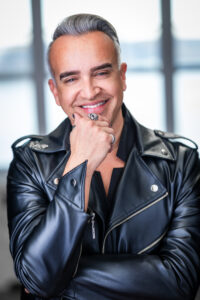From a very young age he knew he was different in spirit, two-spirits to be exact. Yet, he pushed through, did the things that were expected of him, and yet, never lost sight of the essence of who he was.
While he left the world of music for a time, the music never left him and the kaleidoscope of his life finally caught back up to him, nudging him back into his passion of music, story telling, and writing about the beauty of being an Indigiqueer artist and creative. Roger Kuhn talks about his two-spirit roots and being as well as talks about his new pop single Kaleidoscope and his new book Somacultural Liberation.
 About Roger
About Roger
Roger Kuhn’s new single, “Kaleidoscope” – his first since signing with music label, So Fierce Music – is a dance song rooted in classic house and progressive EDM that asks listeners: what do you believe? and what does it mean to be free?
For the artist, freedom is pursing his dreams and living his truth, which is why after working as a psychotherapist for the past decade, Kuhn decided to take time away from his practice and prioritize his creative expression once again. “I love being a music artist,” explains the singer-songwriter whose breakout single from 2008, “What’s Your Name,” was crowned Song of the Year by the Stonewall Society for the Arts. “Even the lyrics in “Kaleidoscope” reflect on my joy,” Kuhn continues. “I sing about flying through the sky, never being so high, and how I can’t believe I’m not falling. That’s who I am when I am performing live or writing songs. I am living my ultimate purpose and celebrating my authentic self.”
Roger Kuhn’s real self includes being a bi-racial, bi-cultural, Two-Spirit Indigiqueer artist. His father was of German and Russian descent and his mother is a Poarch Creek woman. He recalls his childhood in rural North Dakota as being a mix of curiosity and wonder where he would spend hours meandering through the forests on the family farm, singing and writing songs. Sadly, there were moments of horror, too, as his father was an abusive alcoholic who terrorized Roger’s family. The pain was further exacerbated by the young boy’s feelings of isolation as he began to question his gender and sexual orientation.
Roger says his gender is best described as circular, meaning he is not on a fixed binary. It is the same with his sexuality. “Gender and sexual orientation can be seen through a kaleidoscopic lens,” he explains. “When you peer through a kaleidoscope you see multiples shapes, colors, expressions, and beauty, which is what life is like if we allow ourselves to see beyond the ordinary.”
Connect With Roger
